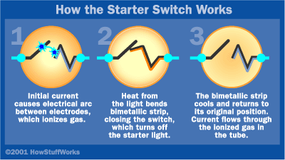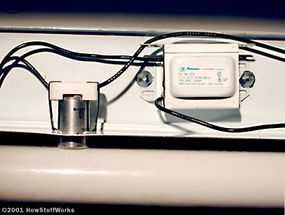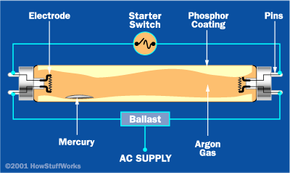Start it Up
The classic fluorescent lamp design, which has fallen mostly by the wayside, used a special starter switch mechanism to light up the tube. You can see how this system works in the diagram below.
When the lamp first turns on, the path of least resistance is through the bypass circuit, and across the starter switch. In this circuit, the current passes through the electrodes on both ends of the tube. These electrodes are simple filaments, like you would find in an incandescent light bulb. When the current runs through the bypass circuit, electricity heats up the filaments. This boils off electrons from the metal surface, sending them into the gas tube, ionizing the gas.
Advertisement
At the same time, the electrical current sets off an interesting sequence of events in the starter switch. The conventional starter switch is a small discharge bulb, containing neon or some other gas. The bulb has two electrodes positioned right next to each other. When electricity is initially passed through the bypass circuit, an electrical arc (essentially, a flow of charged particles) jumps between these electrodes to make a connection. This arc lights the bulb in the same way a larger arc lights a fluorescent bulb.

One of the electrodes is a bimetallic strip that bends when it is heated. The small amount of heat from the lit bulb bends the bimetallic strip so it makes contact with the other electrode. With the two electrodes touching each other, the current doesn't need to jump as an arc anymore. Consequently, there are no charged particles flowing through the gas, and the light goes out. Without the heat from the light, the bimetallic strip cools, bending away from the other electrode. This opens the circuit.

By the time this happens, the filaments have already ionized the gas in the fluorescent tube, creating an electrically conductive medium. The tube just needs a voltage kick across the electrodes to establish an electrical arc. This kick is provided by the lamp's ballast, a special sort of transformer wired into the circuit.
When the current flows through the bypass circuit, it establishes a magnetic field in part of the ballast. This magnetic field is maintained by the flowing current. When the starter switch is opened, the current is briefly cut off from the ballast. The magnetic field collapses, which creates a sudden jump in current -- the ballast releases its stored energy.

This surge in current helps build the initial voltage needed to establish the electrical arc through the gas. Instead of flowing through the bypass circuit and jumping across the gap in the starter switch, the electrical current flows through the tube. The free electrons collide with the atoms, knocking loose other electrons, which creates ions. The result is a plasma, a gas composed largely of ions and free electrons, all moving freely. This creates a path for an electrical current.
The impact of flying electrons keeps the two filaments warm, so they continue to emit new electrons into the plasma. As long as there is AC current, and the filaments aren't worn out, current will continue to flow through the tube.
The problem with this sort of lamp is it takes a few seconds for it to light up. These days, most fluorescent lamps are designed to light up almost instantly. In the next section, we'll see how these modern designs work.
